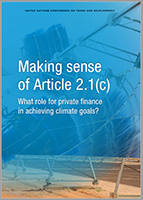
Aligning the whole financial system, encompassing public and private financial flows at the domestic and international level, with a “pathway towards low greenhouse gas emissions and climate resilient development,” as stated in Article 2.1(c) of the Paris Agreement (PA), is fundamental to limiting global warming and supporting the development ambitions of developing countries.
Achieving this goal will require deep and wide-reaching changes in the way financial resources are mobilised, allocated and managed that go beyond simply ‘scaling-up’ climate-aligned finance and ‘scaling-down’ climate-inconsistent finance.
To uphold the ambitions of Article 2.1(c) in the Paris Agreement (PA), governments will need work with central banks, financial supervisors, and multilateral financial institutions to change the rules and processes that underpin financial decision-making and keep financial markets locked into a high-emissions, business-as-usual pathway.
This report discusses the implementation of Article 2.1(c), and its complementarity with Article 9, with a particular focus on the private sector and the mobilisation of private capital towards low- GHG and climate-resilient development.
Section 1 summarises current challenges in the climate finance landscape and the relationship between Article 2.1(c) and Article 9.
Section 2 considers the misalignment of finance with PA targets, using the example of the role of the banking sector in financing the fossil fuel industry.
Section 3 considers the realignment of private sector finance away from high-emissions industries and towards low-GHG and climate resilient investments through policy and regulatory measures.
Section 4 explores the mobilisation of private capital towards low-emissions and climate-resilient development in developing countries, in relation to Article 9, discussing the barriers and opportunities to the just and equitable delivery of climate finance.
Section 5 concludes with key policy messages.




